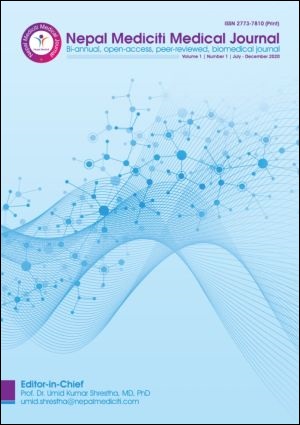Clinical and Echocardiographic Profile of Patients with Atrial Fibrillation Presenting in Tertiary Care of Nepal
DOI:
https://doi.org/10.3126/nmmj.v1i1.34452Keywords:
Atrial fibrillation, Rheumatic Heart Disease, EchocardiographyAbstract
Background: Atrial Fibrillation (AF) is one of the commonest arrhythmias with significant morbidity and mortality where there is uncoordinated activation of atrium leading to mechanical dysfunction of heart. Though rheumatic heart disease is very rare in the western world, it is still prevalent in developing country like Nepal. There is increased risk of development of heart failure, transient ischemic attack/stroke with increased rates of hospitalization.
Methods: This study was a descriptive cross sectional study done in 70 admitted cases of two tertiary centres of Kathmandu (Bir Hospital and Sahid Gangalal National Heart Centre) from February 2018 to August 2018, presenting with history and clinical examination suggestive of Atrial Fibrillation and diagnosis confirmed by 12 lead ECG.
Results: Among 70 cases, female to male ratio was 2.2:1. The mean age of patients was 60.03 ± 19.60 years with dyspnea (91%) followed by palpitation (76%) being commonest presenting symptoms. 15% of cases presented with Stroke. The most common etiology was rheumatic Heart Disease (38.6%) with female predominance. The most common valvular involvement was of mitral valve (71.4%). 8.6% of patients had clots in Left Atrium and majority had LA size >4cm.
Conclusion: In contrary to the studies in the western world, the most common etiology of AF is rheumatic Heart Disease with patients of younger age group with female predominance. Majority of the cases had structural abnormalities in echocardiographic study and left atrial enlargement was common finding risking for thrombus formation and embolization.
Downloads
Downloads
Published
How to Cite
Issue
Section
License
This license enables reusers to distribute, remix, adapt, and build upon the material in any medium or format, so long as attribution is given to the creator. The license allows for commercial use.

